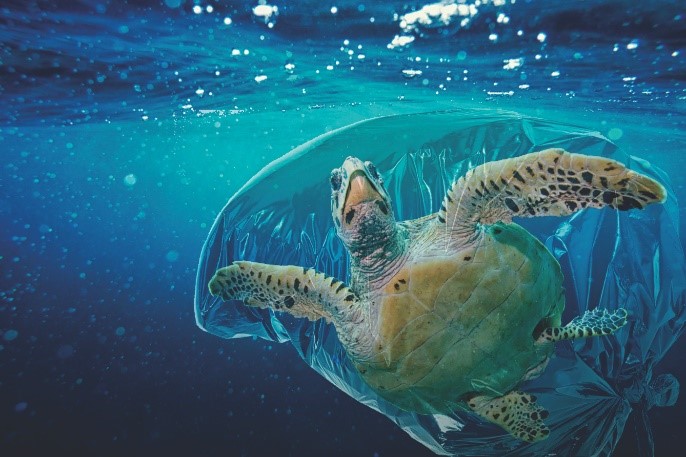
Disclaimer: Copyright infringement not intended.
Context
- In a recent study, researchers from Canada, the Netherlands, and the U.S. have reported that coastal lifeforms have colonized plastic items in the Great Pacific Garbage Patch.
About Great Pacific Garbage Patch
- The Great Pacific garbage patch is a garbage patch, gyre of marine debris particles, in the central North Pacific Ocean.
- The collection of plastic and floating trash originates from the Pacific Rim, including countries in Asia, North America, and South America.
Description
- There are some water currents in the oceans that, driven by winds and the Coriolis force, form loops. These are called gyres. The North Pacific Subtropical Gyre (NPSG) is one such, located just north of the equator in the Pacific Ocean.
- NPSG consists of the Kuroshio, North Pacific, California, and North Equatorial currents. It moves in a clockwise direction.
- These currents flow adjacent to 51 Pacific Rim countries. Any trash that enters one of these currents, from any of these countries, could become part of the gyre.
- Inside this gyre, just north of Hawai’i, lies a long east-west strip where some of the debris in these currents has collected over the years. The eastern part of this is the Great Pacific Garbage Patch.
- The Great Pacific Garbage Patch is, 6 million sq. km big and more than 50 years old.

Contents of the Great Pacific Garbage Patch
- The patch contains an estimated 45,000-1,29,000 metric tonnes of plastic, predominantly in the form of microplastics.
- The numerical density of plastics here is around 4 particles per cubic meter.
- Mass-wise, however, heavier, more visible objects that haven’t yet broken down into smaller particles accounted for 92% in 2018.
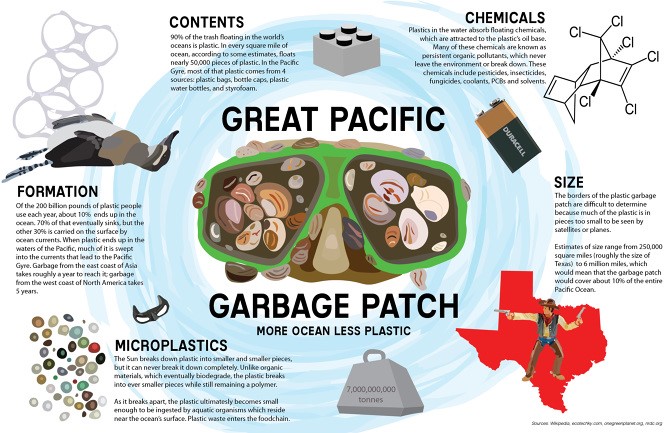
Source of Debris
- The tsunami off the Japanese coast in 2011 contributed to the debris in this garbage patch.
- Until at least 2017, researchers had found debris washing ashore on the West coast of North America containing live lifeforms originally found in Japan.
- From November 2018 to January 2019, researchers collected 105 pieces of plastic debris from the eastern part of the NPSG, “the most heavily plastic-polluted ocean gyre on the globe.
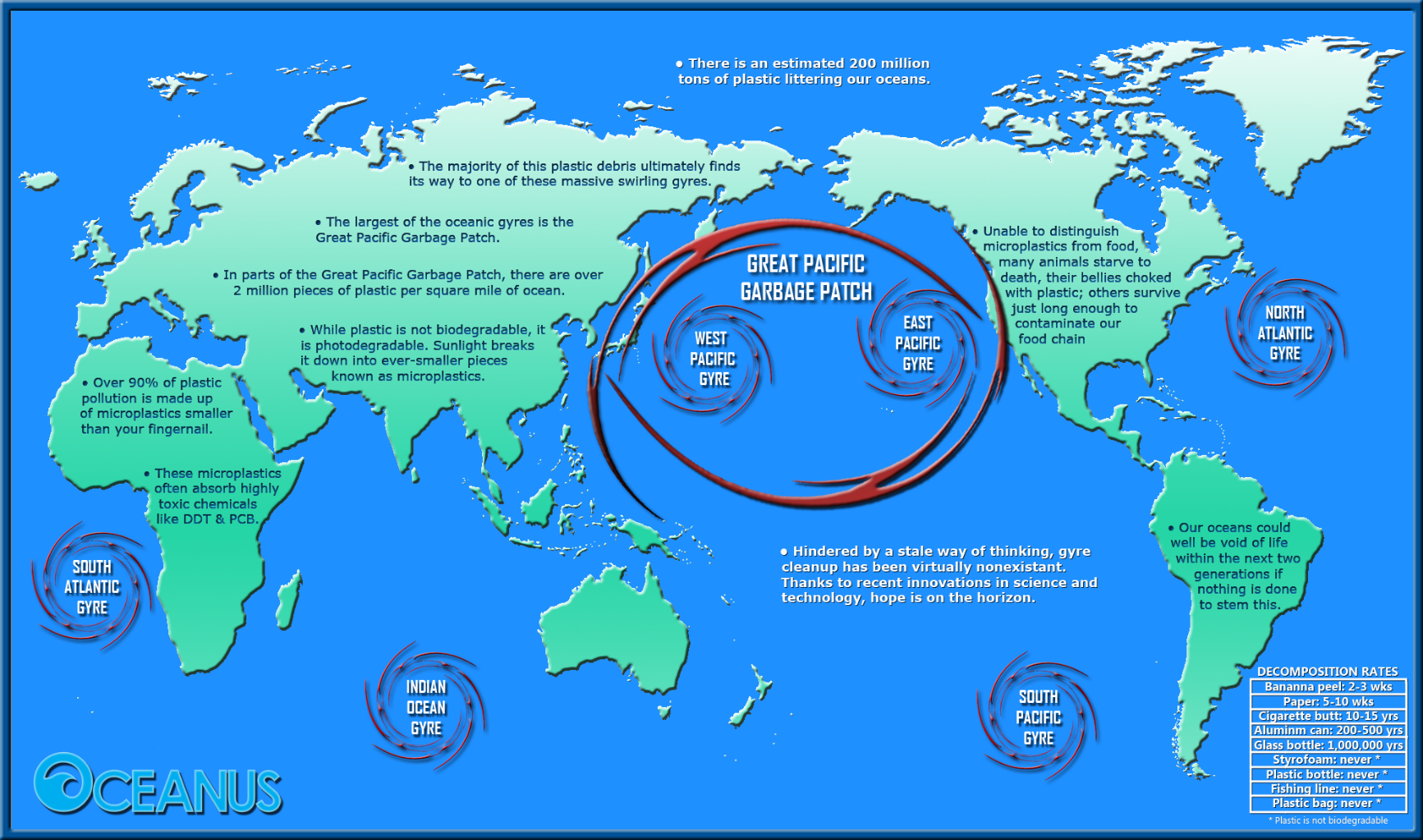
Here are the basic facts about the Pacific Ocean Garbage Patch;
- 7 million tons of weight
- Twice the size of Texas
- Up to 9 feet deep
- In the Great Pacific Ocean Gyre there is 6 times more plastic than plankton, which the main food for many ocean animals
- By estimation 80% of the plastic originates from land; floating in rivers to the ocean or blew by the wind into the ocean
- The remaining 20% of the plastic originates from oil platforms and ships
- According to scientists it is the largest plastic dump on earth; so plastic patches are larger than waste dumps on land
- Trash patches consist for 80 percent out of plastic
- Scientific research from the Scrips Institution of Oceanography in California U.S. shows that 5 to 10% of the fish contain small pieces of plastic.
Research of the Debris: Findings and Report
- 98% of the debris items had invertebrate organisms.
- Pelagic species (i.e. of the open ocean) were present on 94.3% of them and coastal species, on 70.5%.
- Organisms found on coasts were getting by on small floating islands of garbage (to humans) out in the Pacific Ocean.
- The number of coastal species such as arthropods and molluscs identified rafting on plastic was over three-times greater than that of pelagic species that normally live in the open ocean.
- In all, they found organisms belonging to 46 taxa, and 37 of them were coastal; the rest were pelagic.
- Among both coastal and pelagic organisms, crustaceans were the most common.
- The coastal species were most commonly found on fishing nets whereas the pelagic species, on crates.
Implications of the New Findings
Emergence of Neopelagic Community
- The introduction of a vast sea of relatively permanent anthropogenic rafts since the 1950s” has given rise to a new kind of “standing coastal community … in the open ocean”. They’ve named it the neopelagic community.
Dependence of Nonpelagic Community on plastics
- While coastal species have been found on human-made objects in the open ocean before, they were always considered to have been “misplaced” from their intended habitats.
- The neopelagic community, on the other hand, is not misplaced but lives on plastic items in the garbage patch, including reproducing there.
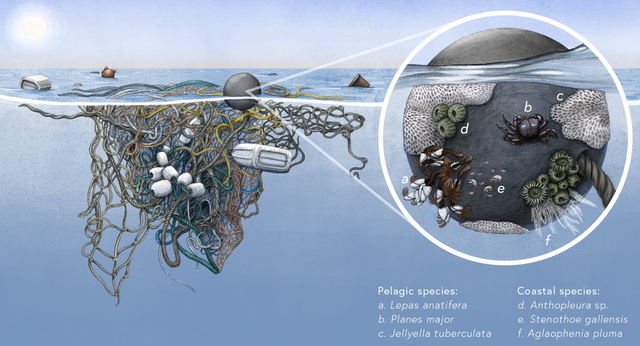
Commencement of the Anthropocene epoch
- The Anthropocene Epoch is an unofficial unit of geologic time, used to describe the most recent period in Earth's history when the human activity started to have a significant impact on the planet's climate and ecosystems.
- As it happens, the layers of rock record everything from the evidence of nuclear tests to the burning of fossil fuels – the Anthropocene epoch can be said to have commenced.
Example, in another recent study researchers reported that polyethylene films had chemically bonded with rocks in China – which is reminiscent, in turn, of the “anthropoquinas” of Brazil (sedimentary rocks embedded with plastic earrings) and the “plastiglomerates” of Hawai’i (beach sediment + organic debris + basaltic lava + melted plastic).
Trivia: Anthropocene Epoch
Background
- The history of planet Earth is long: about 4.5 billion years. Scientists divide up this huge history using geological epochs, eons, eras, and ages to create a timeline.
- Epochs can last for millions of years and are defined by significant changes in rock layers, such as mineral composition and the appearance of distinctive fossils. Each variation reflects a major climatic change.
- For the last 11,500 years, Earth has been in the Holocene Epoch. It began at the end of the last ice age, when glaciers that had previously covered Earth disappeared.
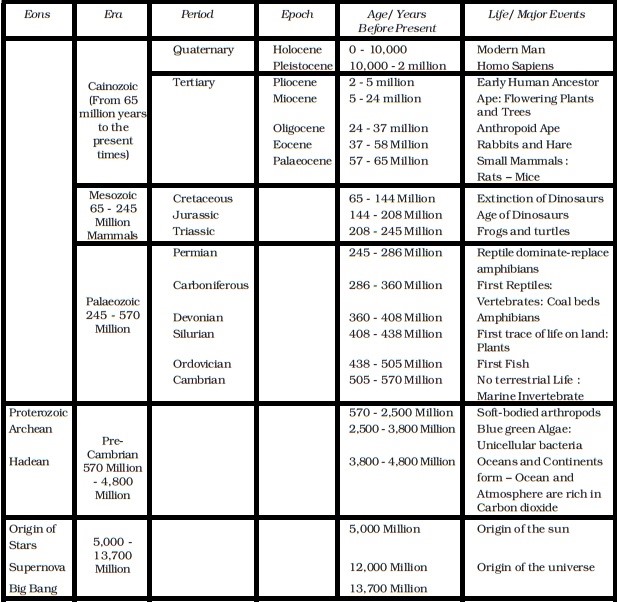
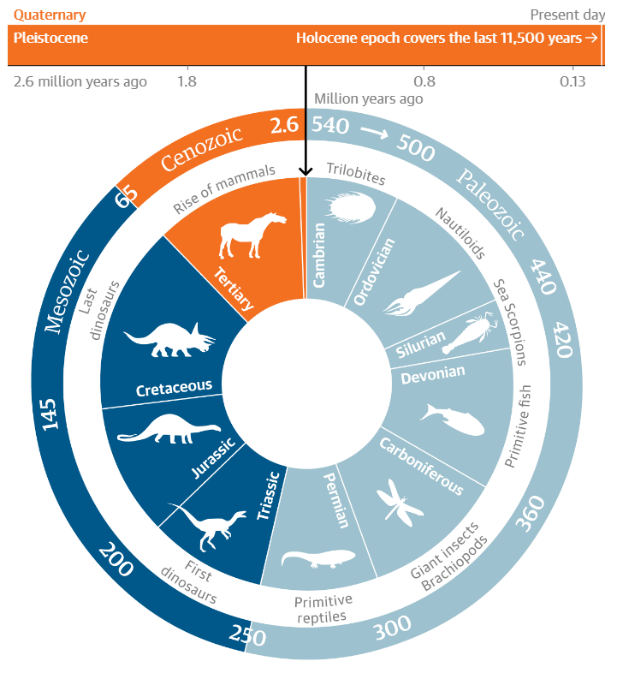
About Anthropocene Epoch
- The word Anthropocene comes from the Greek terms for human ('anthropo') and new ('cene'), but its definition is controversial.
- It was coined in the 1980s, then popularised in 2000 by atmospheric chemist Paul J Crutzen and diatom researcher Eugene F Stoermer. The duo suggested that we are living in a new geological epoch.
- Thus, the Anthropocene is a proposed geological epoch dating from the commencement of significant human impact on Earth's geology and ecosystems, including, but not limited to, anthropogenic climate change.
Note: Neither the International Commission on Stratigraphy (ICS) nor the International Union of Geological Sciences (IUGS) has officially approved the term as a recognized subdivision of geologic time, although the Anthropocene Working Group (AWG) of the Subcommission on Quaternary Stratigraphy (SQS) of the ICS voted in April 2016 to proceed towards a formal golden spike (GSSP) proposal to define the Anthropocene epoch in the geologic time scale (GTS)
Description
- It is widely accepted that our species, Homo sapiens,has had such a significant impact on Earth and its inhabitants that we will have a lasting - and potentially irreversible - influence on its systems, environment, processes and biodiversity.
- The Earth is 4.5 billion years old, and modern humans have been around for around a mere 200,000 years. Yet in that time we have fundamentally altered the physical, chemical and biological systems of the planet on which we and all other organisms depend.
- In the past 60 years in particular, these human impacts have unfolded at an unprecedented rate and scale. This period is sometimes known as the Great Acceleration. Carbon dioxide emissions, global warming, ocean acidification, habitat destruction, extinction and widescale natural resource extractionare all signs that we have significantly modified our planet.
- Not everyone agrees that these changes represent enough evidence to declare a new formal geological epoch, the Anthropocene. Scientists all over the world are still debating.
How has Earth changed during our current epoch?
- The Holocene has seen major change on our planet, including the rapid population growth of our species and the development of modern civilisations.
- In the last 11,500 years, humans have built cities and achieved colossal technological advancements.
- Since the last ice age, Earth's climate had been relatively warm and stable.

Signs of the Anthropocene
- It is clear that our climate is no longer stable and is beginning to warm rapidly.
- Scientists now agree that human activity, rather than any natural progress, is the primary cause of the accelerated global warming. Agriculture, urbanisation, deforestation and pollution have caused extraordinary changes on Earth.
- Geologists disagree over whether humans will have a lasting and meaningful impact on the chemical composition of the rocks and fossils beneath our feet. This is what will need to be proven to declare a new epoch.
- The International Commission on Stratigraphy - the body which oversees how we talk about the history of Earth - has the power to decide on and name geological epochs. They are still debating the proof for the Anthropocene and are looking for what's known as a 'golden spike' - a marker in the fossil record which could demarcate the Holocene from the Anthropocene.
- This marker will have to be so significant that it would be detectable in rock layers thousands and even millions of years into the future.
Radioactive Debris
- The radioactive debris from nuclear bombs made its way into rocks, trees and the atmosphere - they may represent the golden spike that scientists are searching for. Currently there is no clear consensus.
Plastic
- Plastic could become a key marker of the Anthropocene. Earth is now awash with plastic - millions of tons are produced every year. Because plastic doesn’t biodegrade, it ends up littering soils and ocean beds.
- There is already some evidence that plastic is being deposited into the fossil record. A 2019 study of sediments off the Californian coast found that plastic deposits have been rising since the 1940s.
- Plastic pollution is another marker that scientists are studying to find out whether they could be the golden spike, the signifier of the Anthropocene.
In a nutshell,
Evidence of the Anthropocene
Human activity has:
- Pushed extinction rates of animals and plants far above the long-term average. The Earth is on course to see 75% of species become extinct in the next few centuries if current trends continue.
- Put so much plastic in our waterways and oceans that microplastic particles are now virtually ubiquitous, and plastics will likely leave identifiable fossil records for future generations to discover.
- Doubled the nitrogen and phosphorous in our soils in the past century with fertiliser use. This is likely to be the largest impact on the nitrogen cycle in 2.5bn years.
- Left a permanent layer of airborne particulates in sediment and glacial ice such as black carbon from fossil fuel burning.
Anthropocene and extinction

Silver Lining
- Since the beginning of humankind, our planet's global ecology has never been in such a critical state as it is today. But we have also never been better equipped with the tools to understand what is happening and what needs to be done.
|
PRACTICE QUESTION
Q. The dawn of the Anthropocene epoch could mark a one-off transformation from a natural world to one where humans will have a lasting - and potentially irreversible - influence on its systems, environment, processes and biodiversity that transcend our limitations and eventually spread their influence far beyond the Earth. Comment.
|
https://www.thehindu.com/sci-tech/energy-and-environment/coastal-species-great-pacific-garbage-patch-neopelagic-anthropocene/article66747236.ece

















